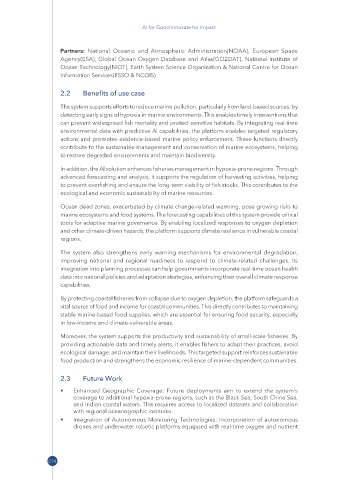Page 250 - AI for Good Innovate for Impact
P. 250
AI for Good Innovate for Impact
Partners: National Oceanic and Atmospheric Administration(NOAA), European Space
Agency(ESA), Global Ocean Oxygen Database and Atlas(GO2DAT), National Institute of
Ocean Technology(NIOT), Earth System Science Organization & National Centre for Ocean
Information Services(ESSO & NCOIS)
2�2 Benefits of use case
The system supports efforts to reduce marine pollution, particularly from land-based sources, by
detecting early signs of hypoxia in marine environments. This enables timely interventions that
can prevent widespread fish mortality and protect sensitive habitats. By integrating real-time
environmental data with predictive AI capabilities, the platform enables targeted regulatory
actions and promotes evidence-based marine policy enforcement. These functions directly
contribute to the sustainable management and conservation of marine ecosystems, helping
to restore degraded environments and maintain biodiversity.
In addition, the AI solution enhances fisheries management in hypoxia-prone regions. Through
advanced forecasting and analysis, it supports the regulation of harvesting activities, helping
to prevent overfishing and ensure the long-term viability of fish stocks. This contributes to the
ecological and economic sustainability of marine resources.
Ocean dead zones, exacerbated by climate change-related warming, pose growing risks to
marine ecosystems and food systems. The forecasting capabilities of this system provide critical
tools for adaptive marine governance. By enabling localized responses to oxygen depletion
and other climate-driven hazards, the platform supports climate resilience in vulnerable coastal
regions.
The system also strengthens early warning mechanisms for environmental degradation,
improving national and regional readiness to respond to climate-related challenges. Its
integration into planning processes can help governments incorporate real-time ocean health
data into national policies and adaptation strategies, enhancing their overall climate response
capabilities.
By protecting coastal fisheries from collapse due to oxygen depletion, the platform safeguards a
vital source of food and income for coastal communities. This directly contributes to maintaining
stable marine-based food supplies, which are essential for ensuring food security, especially
in low-income and climate-vulnerable areas.
Moreover, the system supports the productivity and sustainability of small-scale fisheries. By
providing actionable data and timely alerts, it enables fishers to adapt their practices, avoid
ecological damage, and maintain their livelihoods. This targeted support reinforces sustainable
food production and strengthens the economic resilience of marine-dependent communities.
2�3 Future Work
• Enhanced Geographic Coverage: Future deployments aim to extend the system’s
coverage to additional hypoxia-prone regions, such as the Black Sea, South China Sea,
and Indian coastal waters. This requires access to localized datasets and collaboration
with regional oceanographic institutes.
• Integration of Autonomous Monitoring Technologies: Incorporation of autonomous
drones and underwater robotic platforms equipped with real-time oxygen and nutrient
214

